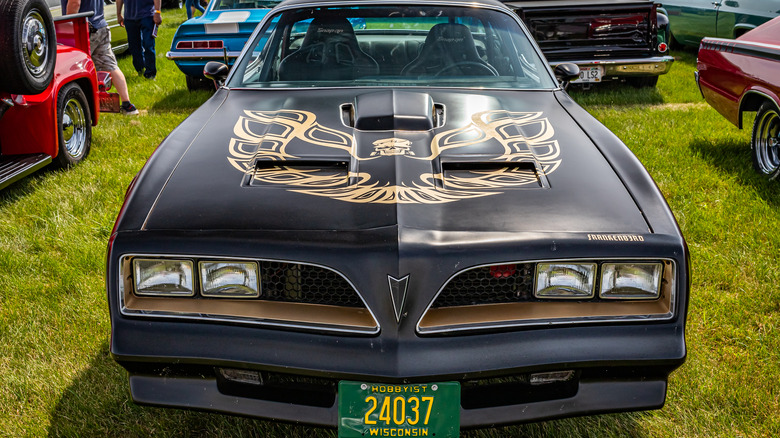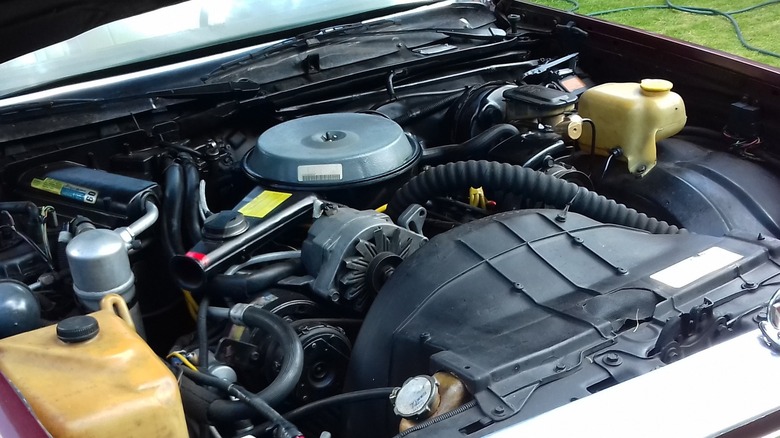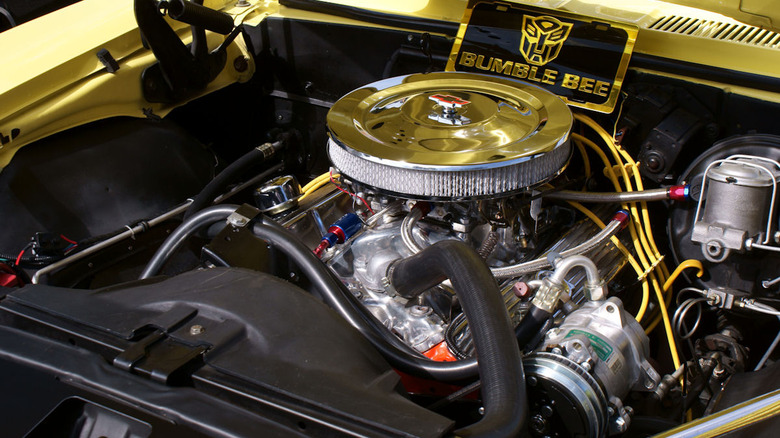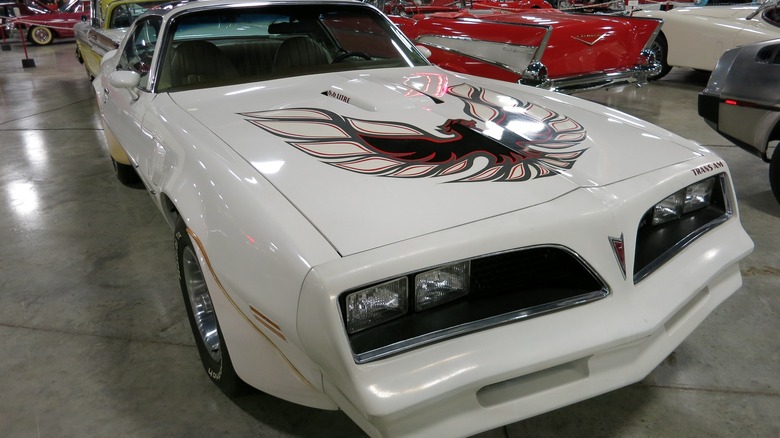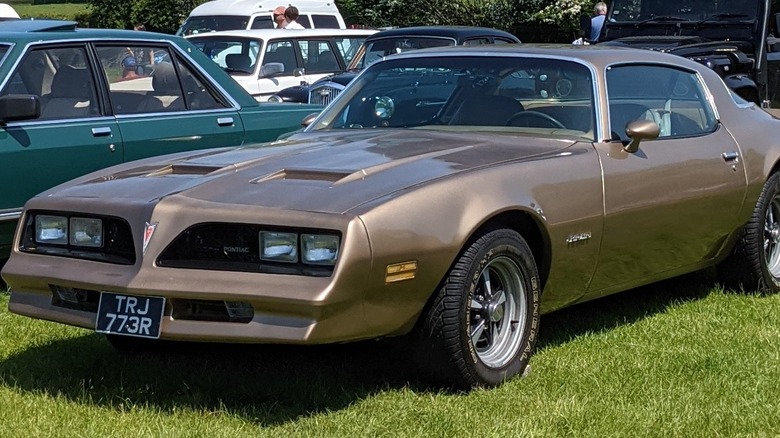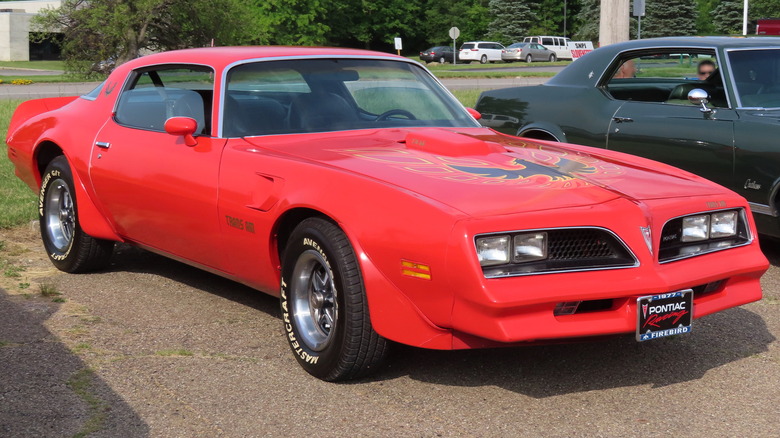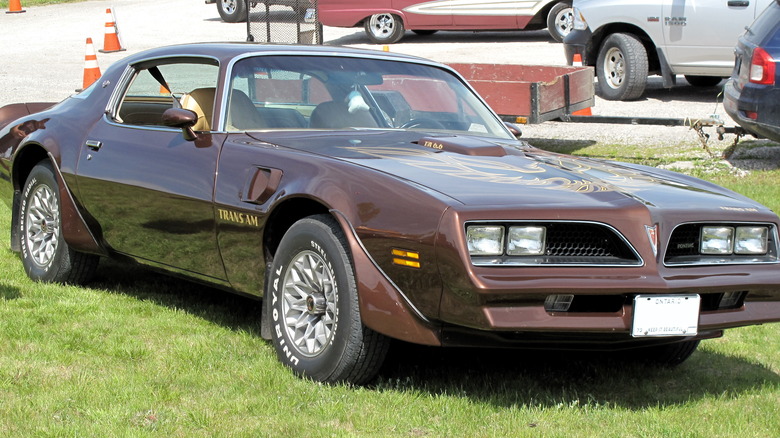All About The Engines That Powered The 1977 Pontiac Firebird
At the beginning of the 1970s, few things were hotter than the American muscle car. These smaller vehicles packed a ton of power and looked like the coolest things on the road. From the Ford Mustang to the Dodge Charger, they were the cars of the era and remain a fascination and collector's item for gear heads today. However, the end of the '70s looked a lot different for the muscle car landscape. With the formation of the Environmental Protection Agency in 1970 and the passing of several laws regulating car emissions and fuel economies, the thunderous engines that once powered these muscle cars couldn't be as thunderous as they once were. The oil crisis in 1973 didn't help either. Car companies had to develop engines that were more efficient and met these regulations to put in these muscle cars.
One of the big muscle cars of the time was the Pontiac Firebird. To demonstrate just how much the engines for muscle cars changed over the decade, all we need to do is look at this car. A 1973 Pontiac Firebird Trans Am Super Duty 455 could get over 400 hp, but by 1977, no engine you could buy in a Firebird was able to get over 200 hp. That isn't to say that these engines were bad, but they needed to evolve with the times. There were a number of engines to choose from for this car, so let's run down the various options.
Buick 231 V6
Typically when we think of a muscle car, we think of some V8 monstrosity rumbling under the hood, but in the case of the 1977 Pontiac Firebird, the standard issue engine was not a V8 at all. Instead, it was the Buick 231 V6, which Buick transitioned to making directly as a result of the 1973 oil crisis, as the company's V8s were just too inefficient. This V6 was designed by jumping off of the Buick's former Fireball V6, but the designers were able to bore it out to match some of the smaller V8s at the time. Because Buick and Pontiac were both owned by General Motors, it was natural to take the engines from one company and bring them over to another.
This Buick 231 V6 engine was not a powerhouse by any means. Under the hood of a Firebird, it was only able to generate about 105 hp and 185-lb-ft of torque. Compared to the heyday of the muscle car, this was nothing, but in the new age of emissions restrictions, you were just going to have to deal with these things. Of course, this was just the standard engine that came with the car. If you want to have something with a little more oomph under the hood, Pontiac had several V8 engines available for you as well.
[Featured image by Jadcol via Wikimedia Commons | Cropped and scaled | CC BY-SA 4.0]
Chevrolet 305 V8
We move from one division of the General Motors Company to another for the next engine that was used for the 1977 Pontiac Firebird. Chevrolet had been making the immensely popular small-block V8 since the 1950s and produced a number of well-loved engines throughout the years, like the immensely popular Chevy 350 V8 engine. Despite the immense popularity of that 350 engine, which they never stopped making, Chevrolet needed a small-block V8 engine in its arsenal that was going to be more efficient and palatable in a post-oil crisis era.
This is where the "underappreciated powerhouse" Chevy 305 V8 engine comes into play. This was an engine that was able to satisfy all these new regulations and could be a reliable, efficient engine for those who still wanted a V8. The power with these engines in the body of a Pontiac Firebird wasn't particularly special, generating about 145 hp and 245-lb-ft of torque, but they got the job done. Because it was basically the same structure and used many of the same parts of the Chevy 350, it was also a relatively easy engine for the company to make, allowing it to be used in many different cars. The Chevy 305 V8 wasn't a marquee engine by any means, but if you wanted a Pontiac Firebird that could handle at least a little bit of power, it was a solid choice.
[Featured image by Valder137 via Wikimedia Commons | Cropped and scaled | CC BY 2.0]
Oldsmobile 350 V8
The next engine on the list lived an incredibly short life under the hood of the 1977 Pontiac Firebird. Not only that, but it also was only available in very specific parts of the country if you wanted it in your car. That engine would be the Oldsmobile 350 V8, known as the Rocket 350. This had been around since 1968, but starting with the 1977 model year, it began using lighter castings. While this did undercut somewhat a V8 engine that was previously a high-compression, powerful machine, you were still able to get a decent amount power with this in the '77 Firebird, as it could generate up to 170 hp and 275-lb-ft of torque.
The wrinkle with the Oldsmobile Rocket 350 was that it wasn't available all over the United States if you wanted it in your Firebird. This was an engine model limited to just California and states with high altitudes. In places where the air is thinner, combustion in an engine becomes a little more difficult because there is less oxygen, so the 4.06 in. bore of the Oldsmobile gave the engine the power it needed to perform properly. However, the Oldsmobile Rocket 350 only lasted in the Firebird for the 1977 model year. After that, Pontiac decided to switch to the popular Chevrolet 350 V8 for this displacement size.
[Featured image by CapCase via Wikimedia Commons | Cropped and scaled | CC BY 2.0]
Pontiac 350 V8
Just because you didn't like in California or a high altitude state doesn't mean you were not going to be able to get a V8 engine with 350 cc of displacement either. You just weren't going to get the one made by Oldsmobile. Instead, the engine that you were going to be getting was a 350 V8 from Pontiac itself. Even though all of the engines mentioned thus far were produced by other companies within GM, Pontiac still made engines, too, and it had its own 350 that was just as powerful as the Oldsmobile.
The big difference was the bore and stroke of the cylinders. The 3.875-in bore of the Pontiac was quite smaller than the Oldsmobile's 4.06-in, but it did have a longer stroke with 3.75-in, compared to the 3.39-in. stroke of the Rocket. Despite the design differences, the Pontiac 350 V8 generated similar power as the Oldsmobile, going up to 170 hp and 280-lb-ft of torque. Because these engines were used closer to sea level, there was less of a need for a big bore and short stroke with the Pontiac, which also made it a more efficient engine. What it also shares in common with the Oldsmobile is that it too was replaced by the Chevrolet 350 V8 when the 1978 model year came around, unifying the 350 displacement engines for the Firebird.
[Featured image by CalReyn88 via Wikimedia Commons | Cropped and scaled | CC BY-SA 4.0]
Pontiac 400 V8
Now, we move into the realm of the high performance side of the Firebird. Like many other car companies, you were able to get an upgraded variation of the vehicle, known as the Pontiac Firebird Trans Am, one of the coolest pony cars of all time. Where the standard engine for the regular Firebird in 1977 was the Buick 231 V6, the Trans Am iteration of the Firebird instead came standard with a Pontiac 400 V8. This was an engine Pontiac had been making since 1967, and the 1977 ended up being the penultimate year of the original design for it.
The Pontiac 400 V8 featured a 4.125-in bore and 3.75-in stroke and could generate up to 180 hp and 325-lb-ft of torque. However, there was an even higher performance version of the Pontiac 400, given the W72 production code rather than the standard L78, which decreased the diameter of the bore to 4.12-in and increased the output to 200 hp. The L78 version of the engine was the standard version because it could better meet the emissions restrictions, so the W72 models were engines that had been stockpiled and would be used for the next few years on the high performance Trans Ams. While the W72 model of the Pontiac 400 was the most power available to a 1977 Firebird Trans Am, you didn't have to get a Pontiac engine.
[Featured image by MercurySable99 via Wikimedia Commons | Cropped and scaled | CC BY-SA 4.0]
Oldsmobile 403 V8
The last and largest engine for the 1977 Pontiac Firebird is the Oldsmobile 403 V8, which basically has the same structure as the previously mentioned Oldsmobile 350 V8 engine, but the main difference is that the bore has been increased from 4.06-in to 4.35-in. Meanwhile, the length of the stroke remained the same, so now the engine was able to increase its output from 170 hp to 185 hp. The torque was really where you saw the increased power, going from 275- to 325-lb-ft.
Like the Pontiac 400, the Oldsmobile 403 V8 was only available for the Trans Am version of the Firebird, but it also had California and high altitude stipulations if you wanted it for the Formula iteration of the car. This was also a higher performance version of the Firebird, but it lacked certain trim features that were present on the Trans Am. Typically, the standard engine for the Formula was the Chevrolet 305 V8, and anything larger than that was also available for it as well. The sole caveat was the location-specific markers for the Oldsmobile 403, as it's larger bore made it applicable to those driving locations with less oxygen.
Having six different engine options available to the entire 1977 Pontiac Firebird line allowed the company to tailor its vehicle to whatever the customer was looking for: Power, efficiency, or just being able to get through the day.
[Featured image by Elise240SX via Wikimedia Commons | Cropped and scaled | CC BY-SA 4.0]
